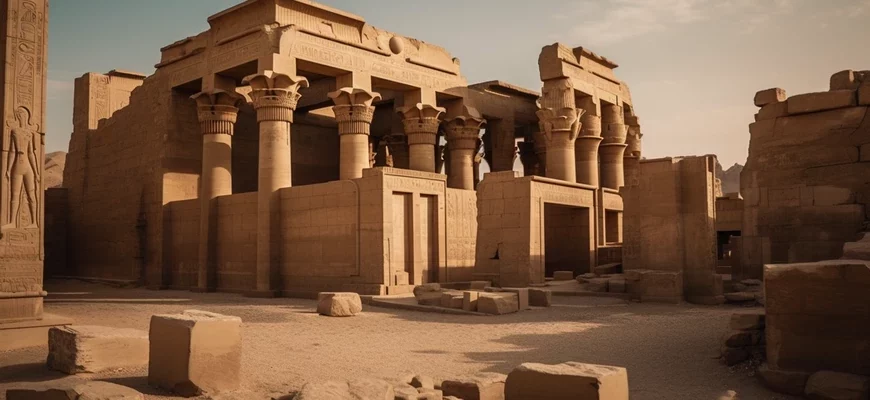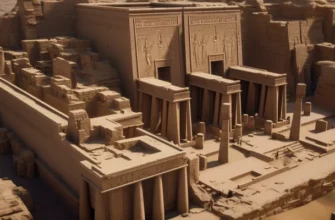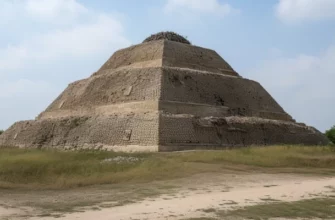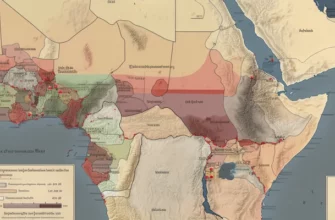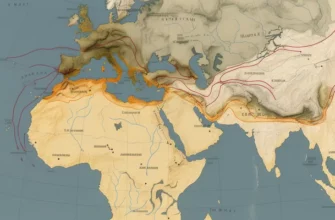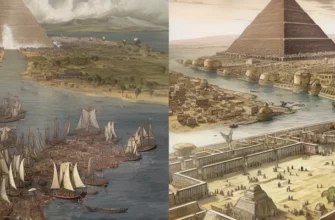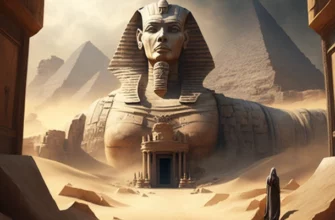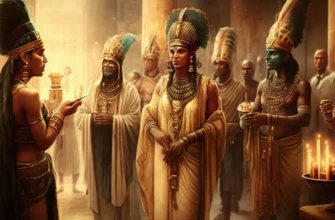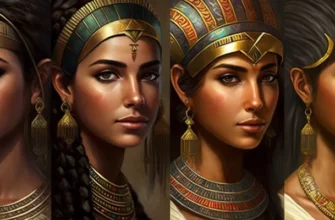The Middle Kingdom was a period in ancient Egyptian history that lasted from 2005 to 1715 BC. The country was united under one ruler, and the economy and culture flourished. Governance was more centralized, and new forms of state control emerged. The Middle Kingdom was a period of prolific art and flourishing religious beliefs. However, later, with the emergence of internal conflicts, this period ended with the fall and collapse of the state.
Political life in the Middle Kingdom
The Middle Kingdom in Egypt, which existed from approximately 2005 to 1715 BC, was a period of stability and development. The political system during this period was not very democratic, as all power was held by the pharaoh. However, in the Middle Kingdom, the pharaohs were less authoritarian than in the Old Kingdom and made more active use of advisors and councils for decision-making.
The pharaohs of the Middle Kingdom expanded their control over the territory of Egypt and began to construct new buildings, including defensive walls and fortresses. They also expanded trade with other countries, which increased Egypt’s wealth and prosperity.
During this period, new state institutions were created, such as military institutions and administrative centers. In addition, a compensation system was established for workers who worked on the pharaohs’ construction projects.
During the Middle Kingdom, new religious practices developed that placed more emphasis on belief in the soul and its afterlife. This changed the approach to tomb culture, leading to the preservation of many valuable artifacts.
In general, political life in the Middle Kingdom was aimed at increasing the power of the pharaohs and ensuring the stability of the country. They used various means to maintain their power, including techniques of intimidation and mythology. However, this period was also marked by the growth of democratic tendencies, such as openness to the advice of other scholars and advisors to the pharaoh, who could give advice on domestic and foreign policy issues.
In addition, the Middle Kingdom was a period of economic growth, which led to the development of crafts and trade. In this regard, new professions and social classes emerged that influenced the political system. For example, merchants and craftsmen gained more influence in society and the ability to defend their rights.
Although the pharaohs held all the power, they could not oppose all the social groups in the country, which had their own interests and needs. That is why the pharaohs were forced to listen more carefully to the opinions of representatives of other social classes and to ensure their interests were met.
During this period, many new artistic masterpieces were also created, reflecting the prosperity of Egypt and its culture. This created a favorable atmosphere for the development of science, literature, and philosophy, which gave impetus to greater freedom of thought and ideas.
Thus, political life in the Middle Kingdom reflected the processes of social development and political evolution. Although the pharaohs held power, they were forced to take into account the opinions of other social groups, and economic development stimulated the growth of new social classes and professions. All this created the preconditions for the further development of Egyptian civilization.
Unification of the country
The Middle Kingdom (2005-1715 BC) in Egypt was a period of political, economic, and cultural prosperity. One of the most important events of this period was the unification of the country.
Before uniting the country, it was necessary to define its borders. Therefore, in the middle of the 3rd millennium BC, 42 nomes were created – territorial units that had their own governors and were ruled by local leaders.
The unification of Egypt took place under the leadership of Mentuhotep II, a pharaoh from the 11th nome, who consolidated his power in Upper Egypt and then marched on Lower Egypt and conquered it. After unifying the country, Mentuhotep II created a centralized state that included all the nomes.
After unifying the country, the pharaohs began reforms in the administration of the state. They established new standards for the exchange of goods, created new laws, and organized a new administrative system. Reforms were also carried out in agriculture, which contributed to increased yields and the development of trade.
During this period, a new art form emerged that reflected a new era in Egyptian history. The pharaohs began building new temples and palaces, which became symbols of the state’s power and prosperity. They also began building pyramids, structures that symbolized eternity and the pharaohs’ power over the country.
Thus, the unification of the country in the Middle Kingdom was an important historical event that gave impetus to the development of the country in many areas of life. The management of the state became more centralized and efficient, which contributed to increased stability and economic development.
The unification of the country also contributed to the emergence of new cultural and artistic traditions. New works of art were created that reflected the prosperity of the state and the power of the pharaohs. This gave impetus to the development of architecture, sculpture, painting, and other types of art.
All this was made possible by the unification of the country and the reforms carried out by the pharaohs of the Middle Kingdom. This period in the history of Egypt was quite long and significant, and its influence was felt for many centuries.
Social structure and governance
The Middle Kingdom (2005-1715 BC) is a period in the history of Ancient Egypt when stability and order were established after a period of disintegration and fragmentation during the First Intermediate Period. The social structure and governance during this period were highly developed.
The social structure of the Middle Kingdom was hierarchical. At the top was the pharaoh, who was considered a god-man and had direct access to divine power. Below him in rank were officials who ruled the country on behalf of the pharaoh. Officials included military leaders, treasurers, judges, appointed city governors, and other high-ranking officials.
Below them in rank were artisans, peasants, and laborers, who made up the majority of the population. Peasants were responsible for growing food crops and performing labor in the fields, while laborers performed construction work and other types of manual labor.
The administration of the Middle Kingdom was centralized. The pharaoh and his officials had complete control over the country, and they made all important decisions. The government was organized into state departments, each responsible for its own specific area of administration. Special departments were responsible for military affairs, finance, agriculture, trade, and construction.
New legislative institutions were also created in the Middle Kingdom to regulate life in the kingdom. Laws were developed on property, inheritance, marriage, crimes, and punishments. These laws became the basis for the further development of legislation in Egypt.
In addition, the administration of the Middle Kingdom was influential in foreign policy. The pharaoh was actively involved in diplomacy, establishing diplomatic relations with neighboring countries, waging wars, and organizing expeditions to acquire new territories and resources.
New technologies were introduced in the Middle Kingdom, which helped to increase production efficiency and improve the lives of the population. New methods of irrigation and land cultivation were developed, ensuring high yields. New construction methods were also developed during this period, allowing for the construction of more complex and large-scale buildings.
Overall, the Middle Kingdom was characterized by stability and prosperity, which was made possible by effective management and a developed social structure. Great attention was paid to culture and science, which contributed to the development of literature, art, medicine, and other fields.
Economic life in the Middle Kingdom
Economic life in the Middle Kingdom (2005-1715 BC) was characterized by a high level of development in agriculture, crafts, and trade.
Agriculture was the main occupation of the population. During this period, new methods of farming were developed in Egypt, which allowed for high yields. Irrigation canals were built to provide water to lands located far from rivers and lakes. Yields increased thanks to the use of new tools, such as the plow, which allowed larger areas of land to be cultivated in a short time. Increased production boosted domestic trade, which contributed to the development of trade and crafts.
Crafts were also highly developed. New industries emerged in the Middle Kingdom, such as metalworking and glassmaking. Textile production, among which linen and cotton fabrics occupied an important place, also developed. Craftsmen began to produce a variety of items, such as chests, furniture, tableware, jewelry, and other household items.
Trade in the Middle Kingdom was highly developed. Egypt was an important trading point on the route between the Mediterranean Sea and the Persian Gulf. It traded with various countries, including Syria, Lebanon, Crete, Cyprus, and others. Trade brought significant profits, which contributed to the development of the economy.
Overall, economic life in the Middle Kingdom was quite stable and prosperous, which ensured the development of culture and art. For example, during this period, new artistic trends and styles emerged, such as “Middle Egyptian” and “Amarna.” Egyptian literature also developed, with new poems, legends, and stories being written.
National income increased during this period, allowing the kingdom to undertake major construction projects and military campaigns. In particular, significant structures such as temples, pyramids, and other buildings were erected. This period also saw the flourishing of urban culture, which manifested itself in the growth of the urban population and the development of infrastructure such as roads, bridges, and other structures.
The Middle Kingdom was governed centrally from the capital city of Memphis. The pharaoh was the supreme ruler of the state and had absolute power over the population. The state was divided into provinces, which were headed by governors who were subordinate to the pharaoh.
The country’s economy and finances were managed by a special council consisting of high-ranking officials. They controlled trade, collected taxes, and ensured economic development.
All these factors contributed to the development of a highly cultured and prosperous society in the Middle Kingdom.
Another important economic aspect of the Middle Kingdom was the development of agriculture. The Egyptian pharaohs of that time actively used irrigation systems, which allowed them to grow a variety of crops on large areas of land. In particular, wheat, barley, soybeans, cotton, flax, as well as vegetables and fruits such as grapes, dates, and others were grown.
To ensure the prosperity of the population and the military power of the state, the Middle Kingdom actively engaged in foreign trade with neighboring countries. Egypt exported its goods, such as grain, fabrics, jewelry, and others, receiving imported goods in return. Trade was conducted both along the Nile and beyond, particularly with countries in the Mediterranean and the Middle East.
An important economic factor was also the developed system of slavery. Slaves were used in agriculture, construction, mining, and the arts. Although slavery was a cruel form of human exploitation, it was not as widespread in the Middle Kingdom as it was in later periods of Egyptian history.
Thus, economic life in the Middle Kingdom was quite developed and stable, which ensured the prosperity of culture and art, the development of cities, agriculture, and foreign trade. The country was governed centrally by a hierarchy of officials who performed various functions, from collecting taxes to managing military affairs.
Agriculture
The Middle Kingdom refers to the period of Egyptian history between 2055 and 1650 BC. Agriculture during this period was the main industry and way of life for the Egyptians.
Agriculture was organized on the basis of an irrigation system that had been built in the previous period of Ancient Egypt. Using canals, rivers, and lakes, water was delivered to the fields where the main crops were grown, such as wheat, barley, soybeans, cotton, flax, and vegetables.
In the Middle Kingdom, agriculture was quite developed and mature. The pharaohs who ruled during this period supported the development of agriculture by building new irrigation systems and supporting the peasant community.
The main work in agriculture was done by peasants who worked on the pharaohs’ lands. The peasants were organized into communities, each of which had its own plot of land. The peasants paid taxes on their harvests, which were used to finance the needs of the state.
Livestock farming also developed during this period. Peasants kept cows, sheep, and goats for milk, meat, and skins.
In general, agriculture in the Middle Kingdom was the main sector of the economy and helped to ensure stability and prosperity in the country.
Trade and crafts
The Middle Kingdom refers to the period of Egyptian history between 2055 and 1650 BC. During this period, trade and crafts were important sectors of the economy and life of the Egyptians.
Trade in the Middle Kingdom took place at various levels – domestic and foreign. Domestic trade took place between different regions of Egypt and provided for the needs of various goods, such as grain, vegetables, fruits, wood and stone products.
Foreign trade took place with other countries, such as Nubia, Syria, Palestine, and Crete. The main trading centers were cities in northern Egypt, such as Memphis, Heliopolis, and Heliopolis Magna.
Crafts were also developed in the Middle Kingdom. The cities had craft centers where various products were made, such as ceramics, metalwork, textiles, and jewelry.
Craftsmen were organized into guilds that brought together workshops of different crafts. These guilds controlled the quality of products and regulated their prices.
In general, trade and crafts in the Middle Kingdom were important sectors of the economy that helped ensure stability and prosperity in the country.
Cultural life in the Middle Kingdom
Cultural life in the Middle Kingdom was quite developed and had its own characteristics compared to other periods of Egyptian history.
During this period, writing developed. The Egyptians used writing to record their history, religious texts, and administrative documents. The first papyrus scrolls were also created in the Middle Kingdom.
New forms of art also appeared during this period. For example, new forms of sophisticated reliefs appeared on the walls of temples and tombs, depicting people, animals, and plants.
Science also developed during this period. The Egyptians studied astronomy, mathematics, and medicine. They had advanced knowledge of the human body, disease prevention, and treatment.
Religion also developed in the Middle Kingdom. Temples were the centers of religious life and worship, and priests played an important role in the life of the country.
The first mummification rituals also began to appear during this period, which were intended to preserve the bodies of noble persons after death.
In general, cultural life in the Middle Kingdom was diverse and developed, and Egypt became one of the most influential countries of that time.
Religion and mythology
In the Middle Kingdom, religion and mythology played an important role in the lives of the Egyptians. They believed in polytheism and worshipped various deities.
One of the most widespread cults was the cult of Ra, the sun. Ra was the supreme deity and gave life and light to everything on earth. The cults of Amun, Osiris and Isis, Set, and other gods and goddesses were also popular.
Ideas about life after death also developed in the Middle Kingdom. The Egyptians believed that after death, the soul of a person continued to exist in another world called Duat. In order to ensure a successful transition to the afterlife, the Egyptians mummified their bodies and placed them in tombs with household items, food, and drinks.
In the mythology of the Middle Kingdom, much attention was paid to the stories of gods and goddesses. For example, the myth of the god Osiris, who was killed by his brother Set and brought back to life by his wife Isis, is one of the most famous myths in Egyptian mythology.
In general, religion and mythology in the Middle Kingdom reflected the complex worldview of the Egyptians of that time and influenced all spheres of life in the country.
The Fall of the Middle Kingdom
The fall of the Middle Kingdom (2005-1715 BC) is one of the most mysterious and still not fully understood events in the history of Ancient Egypt. Although the exact reasons for the fall of this state are unknown, researchers believe that various factors contributed to its downfall, such as:
The increase in power of local princes, who began to oppose the central authority and take on more powers.
Climate change, which led to a period of drought and famine. This made the economy of the Middle Kingdom less stable and led to a decrease in taxes paid to the central government.
Invasions from the southeast. Groups of tribes from South Sudan often attacked the territories of the Middle Kingdom, leaving destruction and chaos in their wake.
Overall, the fall of the Middle Kingdom led to a period of disintegration and chaos in Ancient Egypt that lasted about 150 years until the advent of the New Kingdom. During this period, the state was divided into several independent parts that were in constant war with each other.
Conclusions
The Middle Kingdom (2005-1715 BC) is one of the most important periods in the history of Ancient Egypt. This period was characterized by significant economic and cultural development of the state, which allowed it to become one of the most powerful states in the world at that time.
During this period, a new system of government was established, based on a hierarchy of princes and high officials who controlled the territory of the state and developed agriculture. Trade and crafts also developed rapidly, ensuring the prosperity of the economy and increasing the wealth of the state.
During this period, cultural life was also revived, new temples were opened, and major construction projects were carried out. Many of them have survived to this day and are an important source for studying the history of this period.
Religious and mythological life also developed very rapidly in the Middle Kingdom. New gods were invented, reflecting the new beliefs and ideology of the state.
Despite all this, the Middle Kingdom was disrupted by various factors that led to its downfall. However, remaining one of the most defining periods in the history of Ancient Egypt, the Middle Kingdom had a significant impact on the further development of the country, and its achievements are an example of how a great state can be successful if it knows how to properly organize its society and economy.
